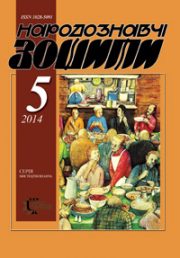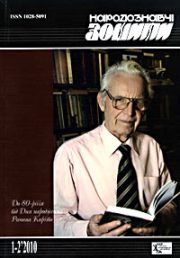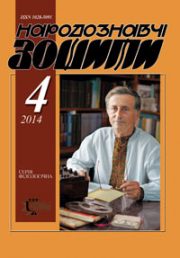The Ethnology Notebooks. 2019, 1 (145), 29—34
UDK 304.44:7.04
DOI https://doi.org/10.15407/nz2019.01.029
DUAL FAITH IN THE MEDIEVAL CULTURE OF PRECARPATHIAN POPULATION
CHUYKO Oleh
ORCID ID: https://orcid.org/0000-0003-3713-5593
Associate Professor, Kandidat of Arts (Doctor of Arts Studies)
Public Higher Education Institution
Vasyl Stefanyk Precarpathian National University
57 Shevchenkа Str., 76018, Ivano-Frankivsk, Ukraine
Contacts: e-mail: art.trivium@gmail.com
Abstract. In an effort to study ancient cultures of the Precarpathian people, archaeological materials assume paramount significance. They create new opportunities for interpreting the historical process, revealing new, sometimes surprising features of cultural life of our ancestors. At various stages of their social development, Precarpathian people evolved different forms of organizing sacred rites. The higher level of public relations was met by sacral centers — ancient settlements (sanctuaries), built in Bukovina, in the Middle Dniester region.
The Aim of the Research. The paper aims to interpret the results of recent archaeological surveys of mountainous areas in the Carpathian region, clarify the semantics of local toponymic names and pre-Christian religious centers and reveal their role in the culture of ancient population of the Carpathians in the dual-faith.
Research methodology. In order to research the material described in the paper we used methods of chronological reconstruction, theoretical, historical, source-study analysis and synthesis, which enabled us to recreate the course of historical, cultural and artistic processes in the specified region. We opted for the use of art-study approach of figurative and stylistic analysis due to the specific character of the research subject.
Findings. In this paper we analyze several versions of the origin of petroglyphs, discovered by Precarpathian archaeologists and historians on rock complexes in the Carpathians. We focus on the petroglyphs carved on rock surfaces and often combining pagan and Christian motifs, which provided the basis for studying contradictory and dynamic sociocultural life of mountain population of Southwestern Rus.
Practical Application. Practical significance of the paper lies in the fact that its conclusions and findings can be used in academic and methodological publications on the History of Ukrainian Culture, as well as delivering lectures on some humanitarian subjects. This paper contains data that could be used in regional studies and tourism, as well as in excursion practice.
Keywords: dual faith, tradition, Christianity, paganism, culture, cult, petroglyphs.
Received 23.01.2019
REFERENCES
Aulikh, V.V. (1972). Ancient settlement near the village of Zymne — Slavic monument of the 6th—7th centuries AD in Western Volyn. Kyiv: Naukova dumka [in Ukrainian].
Bandrivskyi, M. (1992). Faces of Svarozhych. Lviv: Lohos [in Ukrainian].
Borovskiy, Ya.E. (1982). Mythological world of ancient Kyivans. Kyiv: Naukova dumka [in Russian].
Vlasova, G.M. (1962). Bronzeware of the 11th—13th centuries from the village of Zelenche. Reports on the archeology of the Northern Black Sea region, 4, 246—259 [in Russian].
Voznyi, I.P. (1998). Feudal fortified mansion from the village of Chornivka of the 12th—13th centuries. Chernivtsi: Ruta [in Ukrainian].
Voitovych, V. (2002). Ukrainian mythology. Kyiv: Lybid [in Ukrainian].
Humenna, D. (1993). Family album. Svarog and his brothers. Chronicles of Chervona kalyna (guelder rose), 7—9, 67—72 [in Ukrainian].
Darkevich, V.P. (1961). Axe as a symbol of Perun in Ruthenian paganism. Soviet Archeology, 4, 91—101 [in Russian].
Ivanov, V.V., & Toporov, V.N. (2002). Perun. In Slavic Mythology. Moscow: Mezhdunarodnye otnosheniya [in Russian].
Ivakin, H.Yu. (1982). Stories about ancient Kyiv. Kyiv: Radianska shkola [in Ukrainian].
Kirkor, A.H. (2009). Pokuttia from an archaeological point of view (1874). Research. Kolomyia [in Ukrainian].
Klapchuk, M. (1983). Loieva Pantheon. Zhovten, 8 [in Ukrainian].
Klapchuk, M. (1994). Transcarpathian trail. In Strahora. Book about Nadvirna Rayon (pp. 13—18). Lviv [in Ukrainian].
Kuchynko, M. (2008). Volyn and Volyn Polissia culture of princely era. Lutsk [in Ukrainian].
Hypatian Codex translated by L. Makhnovets. (1990). Kyiv: Dnipro [in Ukrainian].
Makarov, N.A. (1992). Ruthenian hatchet amulets. Russian Archeology, 2, 41—56 [in Russian].
Milkov, V.V., & Пилюгина, N.B. (1987). Christianity and paganism: the problem of dual faith. In Introduction of Christianity in Rus (pp. 263—273). Мoscow: Mysl [in Russian].
Rozhko, M., & Bandrivskyi, M. (1995). Medieval Petroglyphs on the Urych rock. In Rocks and caves in the history and culture of the ancient Ukrainian population (pp. 80—82). Lviv [in Ukrainian].
Rybakov, B.A. (1987). Paganism of ancient Rus. Moscow: Nauka [in Russian].
Sokhatskyi, M. (1998). On life and work of archaeologist Gotfryd Ossovsky. Figures in Ukrainian Archeology. Reports and studies on archeology of Prykarpattya and Volyn, 7, 76. Lviv [in Ukrainian].
Stefanovych, M. (1996). Petroglyphs of Hutsulshchyna: current state and research trends. In Rocks and caves in the history and culture of the ancient Ukrainian population (pp. 101—104). Lviv [in Ukrainian].
Janusz, D. (1918). Prehistoric monuments of Eastern Galicia. Lviv [in Polish].







